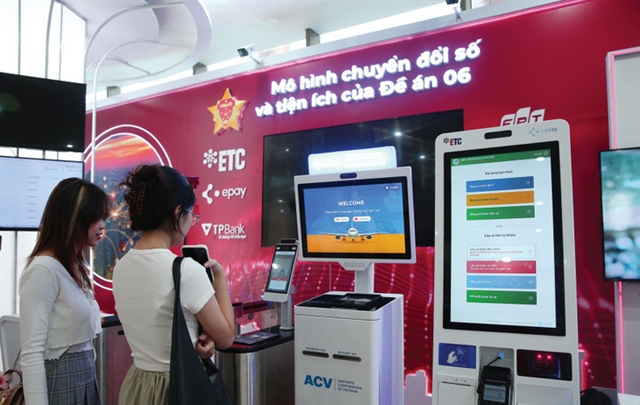 Business Beat
Business Beat


|
| A view of an ABBank’s transaction office in Hà Nội. ABBank is currently the only bank that is listing interest rate of more than 9 per cent per year for 12-month deposits. VNA/VNS Photo |
Compiled by Thu Hà
HÀ NỘI — Interest rates on the interbank market, the open market operation (OMO) channel and commercial banks have all decreased after the State Bank of Vietnam (SBV) cut several policy interest rates last week.
The SBV on March 15 made its first policy rate cut by 50-100 basis points since October 2020 to support economic growth and stabilise the monetary market.
Accordingly, the discount rate has been reduced from 4.5 per cent per year to 3.5 per cent per year while overnight electronic interbank rate and interest rate for loans to offset capital shortages in clearance between the central bank and commercial banks have been also decreased from 7 per cent per year to 6 per cent per year.
After the SBV’s move, interest rates in the inter-bank market have declined significantly. Accordingly, the average overnight interbank lending interest rate on March 15 decreased to around 5 per cent per year from 5.72 per cent on the previous day and 6.22 per cent at the end of the previous week.
Interest rates for one-week, two-week and one-month terms in the inter-bank market dropped sharply to 4.14 per cent, 4.29 per cent and 6.35 per cent per year, respectively. Compared to the end of the previous week, interest rates for the terms decreased by 0.5-1.8 percentage points.
On the OMO channel, the interest rate of winning bids in trading sessions on March 15 and 16 also decreased to 5.5 per cent per year after a long time of staying at 6 per cent per year.
Interest rates listed at commercial banks have also adjusted down after the SBV’s move. Four largest State-owned banks - Vietcombank, BIDV, Agribank and VietinBank - have simultaneously cut their rate by 0.2 percentage points to 7.2 per cent per year for long-term deposits since March 15.
Besides the rate cut for long-term deposits, banks have also reduced the rate for short-term deposits. Nam A Bank and DongABank, for example, have adjusted down the rate for deposits with terms of less than six months by 0.5 percentage points to 5.5 per cent per year, far from the SBV’s regulated cap of 6 per cent per year since March 17.
After several interest rate reductions made by commercial banks recently, only ABBank currently lists an interest rate of 9.1 per cent per year for 12-month deposits and three banks including BaoVietBank, OceanBank and SCB list a 9 per cent rate for 12-month savings.
The remaining banks’ interest rates are all under the threshold of 9 per cent per year for 12-month deposits while the rate of more than 10 per cent per year was popular in the market early this year.
According to Trần Ngọc Báu, CEO of financial data provider Wigroup, the SBV’s move shows the SBV has officially made its first steps to resume its loose monetary policy after a long time applying the tightened policy.
The Government has decided to prioritise economic growth as the country’s GDP has been showing signs of a slowdown, he said.
Analysts from VNDirect Securities Company forecast deposit interest rates to peak in the first quarter of 2023 and then gradually decrease from the second quarter of 2023.
“We expect six-month and 12-month deposit interest rates to gradually reduce to 6.7 per cent and 7.5 per cent by the end of 2023," the analysts said in a recent report.
Liquidity support
To continue reducing market interest rates, Báu suggested the SBV should reduce the remaining policy interest rates such as refinancing rate and actively regulate liquidity in the OMO channel to gradually lower the average interbank interest rate.
The SBV will need to use a combination of other measures, such as expanding OMO liquidity, buying more US dollars and providing special refinancing, to support liquidity for the banking system, Báu said.
In fact, besides the adjustment of the policy rates, notably, the SBV on March 15 also resumed offering the 28-day OMO bid for mortgage loans of valuable papers with an interest rate of 5.5 per cent per year to support longer-term liquidity for commercial banks.
This was the first time since November 2022 that the SBV offered the 28-day bid for mortgage loans of valuable papers. Previously, it offered only 7-day and 14-day bids to support liquidity for commercial banks in the first two months of 2023, after suspending the 91-day bids in mid-December 2022. The move showed the SBV targeted to provide longer-term liquidity for the banking system.
Along with the long-term liquidity injection, the SBV has also continued to stop issuing bills to withdraw cash out of the banking system. Instead, it net injected nearly VNĐ16.1 trillion into the banking system in two sessions on March 15 and 16.
Báu forecast the SBV may have an addition of one or two policy rate cuts in the remaining months of 2023 to support economic growth. However, he noted, the room for the SBV to continue reducing interest rates is not much because Việt Nam previously maintained a low interest rate and increased the rate by only 2 per cent in the past two years.
However, Báu noted, the loosened monetary moves need to be carried out in parallel with small adjustments to minimise adverse impacts on the foreign exchange rate and inflation.
Though inflation is not too high due to low consumption demand, the SBV should still watch the indicator as the promotion of public investment and the looser monetary policy can put pressure on inflation.
Regarding the foreign exchange rate, Báu said, there may be fluctuations in the short term, but the pressure is not great as the SBV can proactively handle it with its available tools. — VNS




